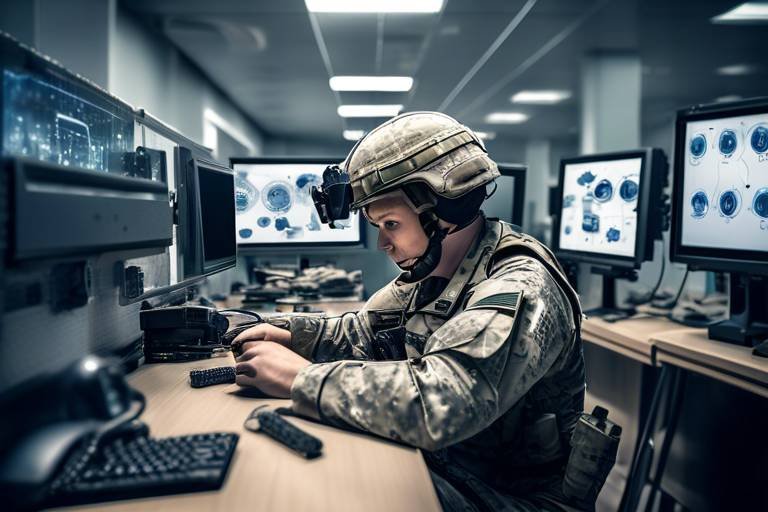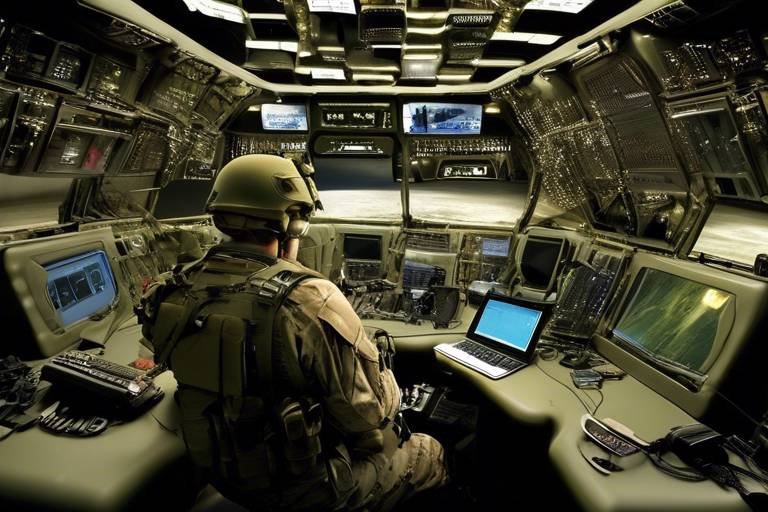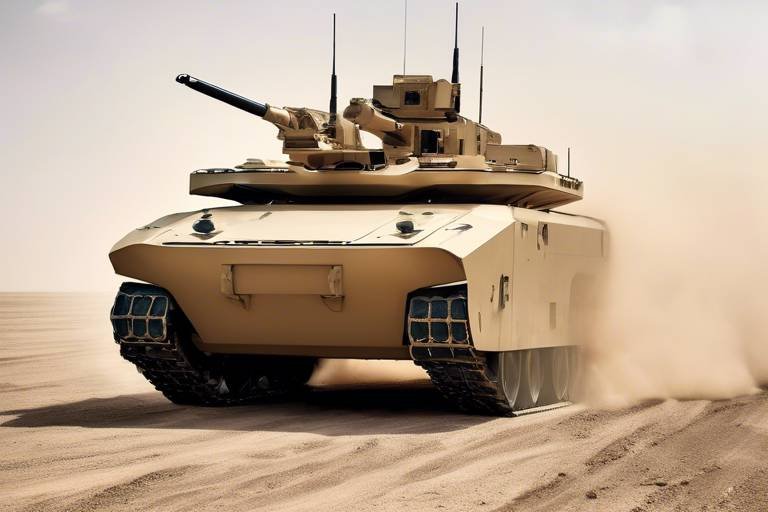The Role of the Internet of Things (IoT) in Defense
The Internet of Things (IoT) is not just a buzzword; it’s a revolutionary technology reshaping various industries, and defense is no exception. Imagine a world where military operations are enhanced by interconnected devices that communicate in real-time, providing crucial data that can mean the difference between success and failure on the battlefield. This article explores the transformative impact of IoT technology on defense systems, enhancing operational efficiency, security, and decision-making processes in modern military applications.
In the heat of battle, situational awareness is paramount. IoT devices provide real-time data that significantly improve situational awareness on the battlefield, enabling military personnel to make informed decisions quickly and effectively. Picture a soldier equipped with wearable technology that tracks their vital signs, location, and surroundings. This data is transmitted to command centers, where it is analyzed alongside information from drones and surveillance cameras. The result? A comprehensive view of the battlefield that allows commanders to strategize effectively, allocate resources efficiently, and respond to threats swiftly.
The integration of IoT in logistics optimizes supply chains, ensuring timely delivery of essential resources and improving inventory management for defense operations. Imagine a scenario where a military base can monitor its supplies in real-time, knowing exactly when to reorder ammunition or food supplies. This capability not only prevents shortages but also reduces waste. For instance, IoT sensors can track the condition and location of supplies, ensuring that everything from fuel to food is delivered exactly when and where it’s needed.
One of the standout features of IoT technology in defense is predictive maintenance. IoT sensors can monitor equipment health, allowing for predictive maintenance that reduces downtime and extends the lifespan of military assets. Think of it like having a personal mechanic for every piece of equipment. Instead of waiting for a vehicle to break down, sensors can alert maintenance crews about potential issues before they become critical. This proactive approach is not only smart but also saves money and enhances operational readiness.
By implementing predictive maintenance, defense organizations can significantly lower operational costs and enhance resource allocation. For example, consider a fleet of military aircraft. By using IoT data to schedule maintenance only when necessary, the military can avoid costly repairs and extend the life of each aircraft. This is a win-win situation: the military saves money while ensuring that its assets are always in top condition.
Predictive maintenance ensures that military equipment is always ready for deployment, enhancing overall mission readiness. In a world where every second counts, having reliable equipment can make all the difference. If a soldier knows their vehicle is in perfect working order thanks to IoT monitoring, they can focus on the mission at hand rather than worrying about mechanical failures.
With the rise of IoT, ensuring robust cybersecurity measures is crucial to protect sensitive military data from potential threats and breaches. The interconnectedness of devices means that a vulnerability in one area could compromise the entire system. Defense organizations must invest in cutting-edge cybersecurity technologies and strategies to safeguard their networks. This includes using advanced encryption methods, regular security audits, and continuous monitoring for suspicious activity. The stakes are high, and the consequences of a breach could be catastrophic.
IoT technology enables the development of smart weapon systems that enhance precision and effectiveness in combat scenarios. Imagine a missile system that can adjust its trajectory in real-time based on data from IoT sensors. This level of precision not only increases the chances of hitting the target but also minimizes collateral damage, which is a critical concern in modern warfare.
The use of IoT in autonomous systems allows for improved decision-making and operational efficiency in various defense applications. Drones equipped with IoT capabilities can gather intelligence, conduct surveillance, and even engage targets without direct human intervention. This not only reduces the risk to soldiers but also enables quicker responses to emerging threats.
IoT devices facilitate real-time targeting and tracking, increasing the accuracy of military operations and reducing collateral damage. By leveraging data from multiple sources, military forces can pinpoint enemy positions with incredible accuracy, ensuring that operations are conducted with minimal risk to civilians. The integration of IoT in targeting systems is a game-changer, allowing for more strategic and ethical military engagements.
Despite its benefits, the implementation of IoT in defense faces challenges such as interoperability, data overload, and security vulnerabilities that must be addressed for effective integration. The sheer volume of data generated by IoT devices can overwhelm systems, making it difficult to extract actionable insights. Additionally, ensuring that different IoT systems can communicate with one another is crucial for maximizing their potential. Defense organizations must navigate these challenges carefully to fully harness the power of IoT technology.
- What is IoT in defense?
IoT in defense refers to the integration of interconnected devices and sensors that communicate data in real-time to enhance military operations.
- How does IoT improve situational awareness?
IoT devices provide real-time data from various sources, enabling military personnel to make informed decisions quickly.
- What are the benefits of predictive maintenance?
Predictive maintenance reduces downtime, extends equipment lifespan, and lowers operational costs.
- What challenges does IoT face in defense?
Challenges include interoperability, data overload, and security vulnerabilities that need to be addressed for effective integration.

Enhancing Situational Awareness
The battlefield is a chaotic and unpredictable environment where every second counts. In this high-stakes arena, situational awareness becomes the cornerstone of military effectiveness. Thanks to the revolutionary advancements in the Internet of Things (IoT), military personnel can now access real-time data that significantly enhances their understanding of the battlefield. Imagine being able to see a live feed of troop movements, environmental conditions, and equipment status all at once. This is the power of IoT technology, transforming how decisions are made during critical operations.
By leveraging a network of interconnected devices, IoT provides a comprehensive view of the operational landscape. Sensors deployed on the ground, in the air, and even in the sea collect vital information that is then analyzed and disseminated to commanders and troops. This real-time data enables military leaders to make informed decisions quickly and effectively, which is essential in dynamic situations where the tide of battle can change in an instant.
For instance, consider a scenario where a unit is engaged in a combat operation. With IoT devices, they can receive instant updates on enemy positions, weather changes, and supply levels. This information not only aids in tactical planning but also enhances communication between units. The ability to share data across various platforms ensures that everyone is on the same page, reducing the chances of miscommunication that could lead to disastrous outcomes.
Moreover, IoT technology is not just about gathering data; it’s about making sense of it. Advanced analytics and machine learning algorithms can process vast amounts of information to identify patterns and predict potential threats. This predictive capability allows military forces to anticipate enemy movements and respond proactively rather than reactively. In essence, IoT transforms data into actionable insights, turning chaos into clarity.
However, while the benefits of enhanced situational awareness are clear, it's essential to recognize the challenges that come with it. The sheer volume of data generated by IoT devices can lead to information overload. Military leaders must be equipped with tools that help filter and prioritize this data to focus on what truly matters. Additionally, the integration of various IoT devices from different manufacturers raises questions about interoperability. Ensuring that all systems can communicate and function seamlessly together is crucial for maximizing the effectiveness of IoT in defense operations.
In conclusion, the integration of IoT technology into military operations is revolutionizing situational awareness on the battlefield. By providing real-time data and advanced analytics, IoT empowers military personnel to make informed decisions faster than ever before. As we continue to explore the potential of this technology, it’s clear that the future of defense will be shaped by our ability to harness the power of connectivity and data.
- What is situational awareness in military terms?
Situational awareness refers to the ability to perceive and understand the elements in the environment, enabling informed decision-making during military operations. - How does IoT improve situational awareness?
IoT enhances situational awareness by providing real-time data from various sensors and devices, allowing military personnel to make quick and informed decisions. - What are the challenges of implementing IoT in defense?
Challenges include data overload, interoperability issues between devices, and the need for robust cybersecurity measures to protect sensitive information.

Streamlining Logistics and Supply Chains
The integration of Internet of Things (IoT) technology in defense logistics is nothing short of a game changer. Imagine a world where military supplies are delivered just in time, where every piece of equipment is accounted for, and where resources can be allocated with pinpoint accuracy. This is the reality that IoT brings to the table. By utilizing an array of interconnected devices, military operations can now operate with unprecedented efficiency. Real-time data collection and analysis allow for a seamless flow of information, enabling decision-makers to act swiftly and effectively.
One of the standout features of IoT in logistics is its ability to optimize supply chains. With the help of IoT sensors and devices, military personnel can track the location and condition of supplies at every stage of the journey. This level of visibility means that delays can be identified and addressed before they become critical issues. For instance, if a shipment of medical supplies is delayed, commanders can be alerted immediately, allowing them to make informed decisions about alternative resources or routes. The ability to monitor conditions, such as temperature and humidity, ensures that sensitive materials are kept in optimal conditions, reducing waste and ensuring readiness.
Moreover, the implementation of IoT in logistics aids in inventory management. Traditional inventory systems often suffer from inaccuracies due to human error or outdated information. However, with IoT, every item can be tagged and monitored in real-time. This means that military units can maintain accurate counts of their supplies, reducing the risk of shortages or overstocking. The result? A more agile and responsive logistics operation that can adapt to the ever-changing demands of military missions.
Another crucial aspect of IoT in defense logistics is the concept of predictive maintenance. IoT sensors can continuously monitor the health of military equipment, collecting data on performance metrics and wear levels. This data allows for predictive analytics, meaning that potential failures can be identified before they occur. For example, if a vehicle's engine is showing signs of wear, maintenance can be scheduled proactively, preventing unexpected breakdowns during critical missions. This not only reduces downtime but also extends the lifespan of military assets, ensuring that they remain operational when needed most.
By implementing predictive maintenance strategies, defense organizations can significantly lower operational costs. According to recent studies, predictive maintenance can reduce maintenance costs by up to 30%. This is a substantial saving, especially when considering the vast array of equipment and resources that military operations require. With fewer unexpected repairs and a more efficient allocation of resources, funds can be redirected to other critical areas, enhancing overall operational effectiveness.
Ultimately, predictive maintenance is about ensuring that military equipment is always ready for deployment. In a world where every second counts, the ability to have fully operational gear can mean the difference between success and failure in a mission. IoT not only keeps track of equipment health but also provides insights that help military leaders make strategic decisions about resource allocation and deployment readiness. This proactive approach to maintenance and logistics is paving the way for a more prepared and responsive military force.
- What is IoT in defense logistics?
IoT in defense logistics refers to the use of interconnected devices and sensors to monitor and manage military supplies and equipment in real-time, enhancing efficiency and decision-making. - How does predictive maintenance work?
Predictive maintenance uses IoT sensors to monitor equipment health, allowing for the identification of potential issues before they lead to failures, thus minimizing downtime and repair costs. - What are the benefits of IoT in military supply chains?
IoT enhances visibility, accuracy, and efficiency in supply chains, ensuring timely delivery of resources and improving inventory management.

Predictive Maintenance
In the fast-paced world of defense, where every second counts, emerges as a game-changer. Imagine a scenario where military vehicles and equipment are not just used until they break down, but are instead monitored continuously to predict failures before they happen. This is precisely what IoT sensors facilitate. By collecting real-time data on equipment performance, these sensors can alert maintenance teams about potential issues long before they escalate into costly repairs or operational failures.
The essence of predictive maintenance lies in its ability to leverage data analytics. With the integration of IoT, military organizations can analyze patterns and trends in equipment performance. For instance, if a sensor detects that an engine is running hotter than normal, it can trigger an alert. This proactive approach not only saves time but also ensures that military assets remain functional and ready for deployment. The result? A more efficient defense operation that can respond to threats swiftly and effectively.
To put it into perspective, consider a military aircraft. These machines are not just expensive; they are vital for national security. By implementing predictive maintenance, defense forces can achieve a significant reduction in downtime. According to recent studies, organizations that adopt predictive maintenance strategies can reduce maintenance costs by up to 30% and extend the lifespan of their equipment by approximately 20%.
| Benefits of Predictive Maintenance | Impact |
|---|---|
| Reduced Downtime | Ensures equipment is operational when needed |
| Cost Savings | Lower maintenance and repair costs |
| Extended Equipment Lifespan | Maximizes return on investment |
| Enhanced Operational Readiness | Improves mission success rates |
Moreover, predictive maintenance fosters a culture of preparedness. Military personnel can focus on strategic planning and operational readiness instead of scrambling to fix broken equipment. This shift not only boosts morale but also enhances the overall effectiveness of the defense forces. When every soldier knows that their equipment is reliable, they can concentrate on their mission without the nagging worry of unexpected failures.
In conclusion, predictive maintenance powered by IoT is not just a technological advancement; it's a revolution in how defense organizations operate. By embracing this proactive approach, they can ensure that their assets are always in peak condition, ready to respond to any situation that arises. As we continue to navigate the complexities of modern warfare, the importance of predictive maintenance will only grow, making it an indispensable part of defense strategy.
- What is predictive maintenance? Predictive maintenance is a proactive approach that uses IoT sensors to monitor equipment health and predict failures before they occur.
- How does IoT enhance predictive maintenance? IoT devices collect real-time data, allowing for detailed analysis and timely alerts about potential equipment issues.
- What are the benefits of predictive maintenance in defense? Key benefits include reduced downtime, significant cost savings, extended equipment lifespan, and improved operational readiness.
- Can predictive maintenance be applied to all military equipment? Yes, predictive maintenance can be implemented across various types of military equipment, including vehicles, aircraft, and weapon systems.

Cost Reduction Strategies
In the realm of defense, where budgets can be as tight as a drum, are not just beneficial; they are essential. One of the most impactful methods for achieving cost savings is through the implementation of predictive maintenance powered by IoT technology. Imagine a scenario where military equipment can communicate its own health status in real-time. This capability allows defense organizations to identify potential failures before they occur, much like catching a cold before it turns into the flu. By addressing issues proactively, the military can avoid costly repairs and extend the lifespan of critical assets.
Moreover, these predictive maintenance systems can significantly reduce the need for extensive inventories of spare parts. Instead of stocking up on every conceivable replacement component, the military can rely on data-driven insights to determine exactly what is needed and when. This streamlined approach not only cuts down on storage costs but also minimizes waste, ensuring that resources are allocated efficiently.
Another major avenue for cost reduction lies in the optimization of logistics and supply chains. IoT devices can track the movement of supplies in real-time, ensuring that they arrive precisely when needed. This level of precision helps in reducing excess inventory and the associated costs of maintaining it. Think of it as a finely tuned orchestra where every instrument plays its part at just the right moment, creating harmonious efficiency.
To illustrate the potential savings, consider the following table that outlines the financial benefits of implementing IoT-driven predictive maintenance versus traditional maintenance strategies:
| Maintenance Strategy | Annual Cost | Downtime (Hours) | Equipment Lifespan (Years) |
|---|---|---|---|
| Traditional Maintenance | $1,000,000 | 500 | 10 |
| IoT Predictive Maintenance | $600,000 | 200 | 15 |
As seen in the table, adopting IoT predictive maintenance can lead to a staggering 40% reduction in annual costs, while also improving equipment readiness and lifespan. This is not just about saving money; it’s about ensuring that the military can operate at peak performance without the financial strain.
In conclusion, as the defense sector increasingly embraces IoT technology, the potential for cost reduction becomes more pronounced. By leveraging data analytics and real-time monitoring, military organizations can not only save money but also enhance their operational capabilities. It's a win-win situation that ultimately leads to a more efficient and effective defense strategy.
- What is predictive maintenance? Predictive maintenance is a proactive approach that uses IoT sensors to monitor equipment health and predict failures before they happen.
- How does IoT improve logistics in defense? IoT technology enables real-time tracking of supplies, optimizing delivery schedules and reducing excess inventory costs.
- What are the financial benefits of IoT in defense? Implementing IoT can lead to significant cost savings through reduced maintenance costs, improved equipment lifespan, and optimized supply chains.

Improving Readiness
In the ever-evolving landscape of defense, readiness is not just a buzzword; it's a fundamental necessity. The integration of Internet of Things (IoT) technology has revolutionized how military organizations prepare for and respond to various threats. Imagine a scenario where military equipment is not only monitored in real-time but is also capable of predicting its own maintenance needs. This is not science fiction; this is the reality that IoT brings to the table.
With IoT sensors embedded in critical military assets, commanders gain access to a treasure trove of data that can significantly enhance operational readiness. These sensors continuously monitor the health and performance of equipment, such as vehicles, aircraft, and weapon systems. By analyzing this data, military personnel can identify potential issues before they escalate into costly failures. For instance, if a sensor detects unusual vibrations in a helicopter rotor, maintenance teams can intervene proactively, ensuring the aircraft is ready for action when needed.
Moreover, the predictive maintenance capabilities of IoT not only extend the lifespan of military assets but also contribute to cost savings. Consider the financial implications: by reducing unexpected breakdowns and maintenance costs, defense organizations can allocate their budgets more effectively. This means more resources can be directed toward training, research and development, and other critical areas that enhance overall military effectiveness.
Another aspect of improving readiness through IoT is the ability to conduct real-time assessments. Imagine a military operation where troops can receive instant updates on the status of their equipment, supply levels, and even enemy movements. This level of situational awareness allows for rapid decision-making, which is crucial in high-stakes environments. For example, if a unit is running low on ammunition, IoT systems can automatically trigger resupply requests, ensuring that troops are never caught off guard.
In addition to equipment readiness, IoT plays a vital role in personnel readiness. Wearable devices equipped with IoT technology can monitor the health and well-being of soldiers in the field. By tracking vital signs and fatigue levels, commanders can make informed decisions about troop deployment and rest periods. This not only enhances individual soldier performance but also contributes to the overall effectiveness of military operations.
In conclusion, the integration of IoT technology in defense not only improves the readiness of military equipment but also enhances the preparedness of personnel. By leveraging real-time data and predictive analytics, military organizations can ensure that they are always one step ahead of potential threats. As we continue to embrace the digital age, the importance of IoT in maintaining operational readiness cannot be overstated. The future of defense is not just about having the right tools; it's about having the right tools ready at the right time.
- What is IoT in defense? IoT in defense refers to the use of interconnected devices and sensors to enhance military operations, improve situational awareness, and streamline logistics.
- How does IoT improve military readiness? IoT improves military readiness by enabling predictive maintenance, real-time assessments of equipment and personnel, and enhancing decision-making capabilities.
- What are the cost benefits of implementing IoT in defense? Implementing IoT can lead to significant cost savings by reducing unexpected maintenance costs and optimizing resource allocation.
- Are there security concerns with IoT in defense? Yes, the implementation of IoT in defense does present security challenges, including the need for robust cybersecurity measures to protect sensitive data.

Data Security and Cyber Defense
This article explores the transformative impact of IoT technology on defense systems, enhancing operational efficiency, security, and decision-making processes in modern military applications.
IoT devices provide real-time data that significantly improve situational awareness on the battlefield, enabling military personnel to make informed decisions quickly and effectively.
The integration of IoT in logistics optimizes supply chains, ensuring timely delivery of essential resources and improving inventory management for defense operations.
IoT sensors can monitor equipment health, allowing for predictive maintenance that reduces downtime and extends the lifespan of military assets.
By implementing predictive maintenance, defense organizations can significantly lower operational costs and enhance resource allocation.
Predictive maintenance ensures that military equipment is always ready for deployment, enhancing overall mission readiness.
As the Internet of Things (IoT) proliferates within the defense sector, the importance of data security and cyber defense cannot be overstated. With countless devices interconnected, the potential for cyber threats increases exponentially. Imagine a vast web where each node represents a military asset, from drones to communication devices. If one of these nodes is compromised, it could lead to a cascading effect, jeopardizing entire operations.
To combat these threats, military organizations must adopt a multi-layered approach to cybersecurity. This includes:
- Encryption: Ensuring that all data transmitted between devices is encrypted to prevent interception.
- Access Control: Implementing strict access controls to limit who can interact with sensitive systems.
- Regular Audits: Conducting frequent security audits to identify vulnerabilities before they can be exploited.
Moreover, the integration of artificial intelligence (AI) into IoT devices can enhance cyber defense mechanisms. AI systems can analyze patterns of behavior and detect anomalies that may indicate a cyber attack. This proactive approach is akin to having a security guard who not only monitors the premises but is also trained to recognize suspicious activity before it escalates.
Despite these advancements, the reality is that no system is entirely foolproof. Defense organizations must remain vigilant and continuously update their cybersecurity protocols to adapt to the ever-evolving landscape of threats. The stakes are incredibly high; the loss of sensitive data could lead to not just operational failures but also compromise national security.
IoT technology enables the development of smart weapon systems that enhance precision and effectiveness in combat scenarios.
The use of IoT in autonomous systems allows for improved decision-making and operational efficiency in various defense applications.
IoT devices facilitate real-time targeting and tracking, increasing the accuracy of military operations and reducing collateral damage.
Despite its benefits, the implementation of IoT in defense faces challenges such as interoperability, data overload, and security vulnerabilities that must be addressed for effective integration.
- What is the Internet of Things (IoT) in defense?
The Internet of Things (IoT) in defense refers to the interconnected network of devices and systems that collect, share, and analyze data to improve military operations. - How does IoT enhance situational awareness?
IoT devices provide real-time data, allowing military personnel to make informed decisions quickly and effectively, thereby enhancing situational awareness on the battlefield. - What are the cybersecurity risks associated with IoT in defense?
With the increased connectivity of devices, the risk of cyber threats rises significantly, making robust cybersecurity measures essential to protect sensitive military data. - Can IoT reduce operational costs in defense?
Yes, by enabling predictive maintenance and optimizing logistics, IoT can significantly lower operational costs and improve resource allocation.

Smart Weapon Systems
The integration of IoT technology into modern military operations has given rise to what we call . These systems are not just your average weaponry; they are equipped with advanced sensors, connectivity, and data analytics capabilities that revolutionize how military forces engage in combat. Imagine a battlefield where every weapon is not just a tool but a smart entity capable of gathering data, communicating with other systems, and making real-time decisions. This transformation is akin to upgrading from a basic flip phone to a sophisticated smartphone—it's a game changer!
One of the most exciting aspects of smart weapon systems is their ability to enhance precision and effectiveness in combat scenarios. For example, traditional weapons may rely heavily on the skill of the operator, but smart weapon systems utilize real-time data to improve targeting accuracy. This means that a soldier can engage a target with a level of precision that was previously unimaginable. With the help of IoT devices, these systems can process vast amounts of data from various sources, including satellite imagery, ground sensors, and even drones, to make informed targeting decisions.
Moreover, the use of smart weapon systems can significantly reduce collateral damage. In a world where every civilian life matters, the ability to strike with pinpoint accuracy is invaluable. Imagine a scenario where a military operation is underway, and a smart missile can differentiate between a legitimate target and a civilian structure based on real-time data. This capability not only saves lives but also helps maintain the moral high ground in military engagements.
Another fascinating feature of smart weapon systems is their autonomous capabilities. These systems can operate independently, making decisions based on pre-programmed algorithms and real-time data analysis. For instance, an autonomous drone equipped with IoT technology can patrol a designated area, identify potential threats, and even engage targets without direct human intervention. This level of autonomy is akin to having a highly trained assistant who can act on your behalf, freeing up military personnel to focus on other critical tasks.
However, the implementation of smart weapon systems is not without its challenges. As with any technology, there are concerns regarding security vulnerabilities. The more connected these systems are, the more susceptible they become to cyber-attacks. Imagine a scenario where an enemy could hijack a smart weapon system, redirecting it away from its intended target. This potential for misuse underscores the need for robust cybersecurity measures to protect these advanced systems. Additionally, the complexity of integrating various technologies can lead to issues with interoperability, where different systems may not communicate effectively with one another.
In summary, smart weapon systems represent a significant leap forward in military technology. They enhance precision, reduce collateral damage, and offer autonomous operational capabilities that were previously the stuff of science fiction. As we continue to explore the potential of IoT in defense, it is crucial to address the challenges that come with it, ensuring that these powerful tools are used responsibly and effectively.
- What are smart weapon systems?
Smart weapon systems are advanced military tools equipped with IoT technology that enhances their precision, effectiveness, and decision-making capabilities in combat scenarios. - How do smart weapon systems improve targeting accuracy?
These systems utilize real-time data from various sources to make informed targeting decisions, significantly increasing their precision compared to traditional weapons. - What are the risks associated with smart weapon systems?
Key risks include potential cybersecurity vulnerabilities and challenges related to interoperability between different systems. - Can smart weapon systems operate autonomously?
Yes, many smart weapon systems have autonomous capabilities, allowing them to make decisions and engage targets without direct human intervention.

Autonomous Systems
The integration of Internet of Things (IoT) technology into autonomous systems marks a revolutionary leap in defense capabilities. Imagine a battlefield where machines can make decisions in real-time, all while communicating with one another and processing vast amounts of data. This is not just science fiction; it's happening now! Autonomous systems, powered by IoT, are designed to enhance operational efficiency and reduce the cognitive load on military personnel.
One of the most significant advantages of these systems is their ability to operate in environments that are too dangerous for human soldiers. For instance, consider drones that can scout enemy positions or deliver supplies without risking lives. These machines are equipped with advanced sensors that gather critical information about the battlefield, which can be relayed back to commanders for strategic planning. This kind of real-time data sharing is a game-changer, allowing for quicker decisions that can turn the tide of battle.
Moreover, the synergy between IoT and autonomous systems leads to improved decision-making. With the ability to analyze data from various sources, these systems can assess threats and opportunities faster than any human operator. For example, an autonomous ground vehicle could evaluate terrain, detect enemy movements, and choose the best route to navigate while avoiding hazards. This level of autonomy not only enhances mission success rates but also minimizes risks to human life.
However, it is essential to recognize that while these systems offer incredible potential, they also come with challenges. The reliance on IoT means that these systems are vulnerable to cyberattacks. If a hacker gains control of an autonomous drone, the consequences could be catastrophic. Therefore, ensuring robust cybersecurity measures is paramount. Defense organizations must invest in securing these systems to prevent unauthorized access and maintain operational integrity.
In summary, the incorporation of IoT into autonomous systems is reshaping the landscape of defense. These technologies not only improve efficiency and safety but also elevate the effectiveness of military operations. As we continue to explore the possibilities of IoT, the future of defense looks increasingly automated and intelligent.
- What are autonomous systems in defense?
Autonomous systems in defense refer to machines and technologies that can operate without human intervention, using IoT to gather data and make decisions in real-time. - How does IoT enhance autonomous systems?
IoT enhances autonomous systems by enabling them to communicate, share data, and analyze information from various sources, leading to improved decision-making and operational efficiency. - What are the risks associated with autonomous systems?
The primary risks include vulnerabilities to cyberattacks, which could compromise the integrity of the systems and lead to potentially dangerous situations. - Are autonomous systems safe to use in military operations?
While they offer significant advantages, safety depends on robust cybersecurity measures and ongoing monitoring to ensure they function as intended without external interference.

Real-time Targeting
This article explores the transformative impact of IoT technology on defense systems, enhancing operational efficiency, security, and decision-making processes in modern military applications.
IoT devices provide real-time data that significantly improve situational awareness on the battlefield, enabling military personnel to make informed decisions quickly and effectively.
The integration of IoT in logistics optimizes supply chains, ensuring timely delivery of essential resources and improving inventory management for defense operations.
IoT sensors can monitor equipment health, allowing for predictive maintenance that reduces downtime and extends the lifespan of military assets.
By implementing predictive maintenance, defense organizations can significantly lower operational costs and enhance resource allocation.
Predictive maintenance ensures that military equipment is always ready for deployment, enhancing overall mission readiness.
With the rise of IoT, ensuring robust cybersecurity measures is crucial to protect sensitive military data from potential threats and breaches.
IoT technology enables the development of smart weapon systems that enhance precision and effectiveness in combat scenarios.
The use of IoT in autonomous systems allows for improved decision-making and operational efficiency in various defense applications.
Real-time targeting is one of the most groundbreaking applications of IoT in defense. Imagine a world where military operations can pinpoint enemy positions with incredible accuracy and speed. This is no longer science fiction; it's a reality made possible by IoT technology. By integrating various IoT devices, such as drones, sensors, and satellite systems, military forces can gather and analyze data instantaneously. This capability allows for rapid response to threats and enhances overall operational effectiveness.
One of the key advantages of real-time targeting is the ability to minimize collateral damage. With precise data on enemy locations and movements, military personnel can make informed decisions about when and where to strike. This not only protects civilian lives but also enhances the legitimacy of military operations in the eyes of the public and international community. The integration of AI algorithms with IoT devices further refines targeting capabilities, allowing for predictive analysis and improved decision-making processes.
Moreover, real-time targeting systems can be visualized through advanced mapping technologies, providing military leaders with a comprehensive view of the battlefield. This visualization can include:
- Heat maps showing troop concentrations
- Live feeds from drones and reconnaissance units
- Geospatial data that highlights terrain advantages
However, the effectiveness of real-time targeting is highly dependent on the reliability of data transmitted from IoT devices. Any disruption or delay in data flow can lead to critical errors in targeting decisions. Therefore, ensuring a robust communication network is essential. Additionally, the military must address potential cybersecurity threats to protect these systems from adversaries who might attempt to jam signals or manipulate data.
In conclusion, real-time targeting powered by IoT is revolutionizing the way military operations are conducted. It enhances precision, reduces risks, and ultimately leads to more successful missions. As technology continues to evolve, we can expect even greater advancements in this area, making the battlefield smarter and more efficient.
Despite its benefits, the implementation of IoT in defense faces challenges such as interoperability, data overload, and security vulnerabilities that must be addressed for effective integration.
- What is IoT in defense?
IoT in defense refers to the integration of internet-connected devices that gather and analyze data to enhance military operations, situational awareness, and decision-making processes.
- How does real-time targeting work?
Real-time targeting utilizes IoT devices to collect and analyze data on enemy positions, allowing military personnel to make informed targeting decisions quickly and accurately.
- What are the security challenges of IoT in defense?
Security challenges include potential cyber threats, data breaches, and the need for robust communication networks to ensure the integrity of transmitted data.
- Can IoT reduce operational costs in the military?
Yes, by implementing predictive maintenance and optimizing supply chains, IoT can significantly lower operational costs and improve resource allocation.

Challenges and Limitations
This article explores the transformative impact of IoT technology on defense systems, enhancing operational efficiency, security, and decision-making processes in modern military applications.
IoT devices provide real-time data that significantly improve situational awareness on the battlefield, enabling military personnel to make informed decisions quickly and effectively.
The integration of IoT in logistics optimizes supply chains, ensuring timely delivery of essential resources and improving inventory management for defense operations.
IoT sensors can monitor equipment health, allowing for predictive maintenance that reduces downtime and extends the lifespan of military assets.
By implementing predictive maintenance, defense organizations can significantly lower operational costs and enhance resource allocation.
Predictive maintenance ensures that military equipment is always ready for deployment, enhancing overall mission readiness.
With the rise of IoT, ensuring robust cybersecurity measures is crucial to protect sensitive military data from potential threats and breaches.
IoT technology enables the development of smart weapon systems that enhance precision and effectiveness in combat scenarios.
The use of IoT in autonomous systems allows for improved decision-making and operational efficiency in various defense applications.
IoT devices facilitate real-time targeting and tracking, increasing the accuracy of military operations and reducing collateral damage.
Despite the numerous advantages that IoT brings to defense systems, there are significant that need to be addressed. One of the primary concerns is interoperability. As various manufacturers create IoT devices, ensuring that these systems can communicate and function together seamlessly is a monumental task. Think of it like trying to fit together pieces of a puzzle from different boxes; some pieces just won’t align, and this can lead to operational inefficiencies.
Another pressing issue is data overload. The vast amounts of data generated by IoT devices can overwhelm military analysts, making it difficult to derive actionable insights quickly. Imagine trying to find a needle in a haystack, but the haystack is constantly growing. This challenge necessitates advanced data processing techniques and algorithms to filter out the noise and focus on what truly matters.
Moreover, security vulnerabilities pose a significant risk. As more devices connect to the internet, the attack surface for potential cyber threats expands. Defense organizations must invest heavily in cybersecurity measures to safeguard sensitive information and maintain operational integrity. A breach in military data could have catastrophic consequences, making this a top priority.
Lastly, the challenge of scalability cannot be overlooked. As defense operations grow and evolve, the IoT systems must also be adaptable and scalable to meet increasing demands. This requires not only technological advancements but also a shift in organizational mindset towards embracing innovation and flexibility.
- What is IoT in defense?
IoT in defense refers to the use of interconnected devices and sensors that collect and exchange data to enhance military operations, improve situational awareness, and streamline logistics.
- How does IoT improve military readiness?
By enabling predictive maintenance and real-time monitoring of equipment, IoT ensures that military assets are always operational and ready for deployment.
- What are the security concerns with IoT in defense?
The primary concerns include data breaches, cyber attacks, and the need for robust cybersecurity measures to protect sensitive military information.
- Can IoT devices be integrated with existing military systems?
Integration is possible but poses challenges such as interoperability and compatibility, requiring careful planning and execution.
Frequently Asked Questions
- What is the Internet of Things (IoT) in defense?
The Internet of Things (IoT) in defense refers to the network of interconnected devices and sensors that collect and share data to enhance military operations. By utilizing IoT technology, defense systems can improve situational awareness, streamline logistics, and enable smarter weapon systems.
- How does IoT enhance situational awareness on the battlefield?
IoT devices provide real-time data that significantly improve situational awareness. This allows military personnel to make informed decisions quickly, adapting to changing conditions and threats on the battlefield, much like having a high-tech map that updates instantly.
- What role does IoT play in logistics and supply chain management?
IoT optimizes logistics by ensuring timely delivery of essential resources and improving inventory management. Think of it as a smart assistant that tracks supplies and alerts personnel when resources are running low, thus preventing delays in operations.
- Can IoT help with predictive maintenance in military equipment?
Absolutely! IoT sensors monitor the health of military equipment, allowing for predictive maintenance. This means potential issues can be identified before they lead to equipment failure, reducing downtime and extending the lifespan of assets.
- What are the cost benefits of implementing IoT in defense?
By utilizing predictive maintenance and optimizing logistics, defense organizations can significantly lower operational costs. It enhances resource allocation, ensuring that funds are used effectively, much like investing in preventive care to avoid costly emergencies later.
- How does IoT contribute to data security in defense?
With the rise of IoT, robust cybersecurity measures are essential to protect sensitive military data from potential threats. It’s like having a security system that not only locks the doors but also monitors for intrusions in real-time.
- What are smart weapon systems and how do they use IoT?
Smart weapon systems are advanced military technologies that leverage IoT for enhanced precision and effectiveness. They utilize real-time data for targeting and tracking, ensuring that operations are conducted with greater accuracy and reduced collateral damage.
- What challenges does IoT face in defense applications?
Despite its benefits, IoT in defense faces challenges such as interoperability among different systems, data overload from vast amounts of information, and security vulnerabilities that must be addressed to ensure effective integration.



















